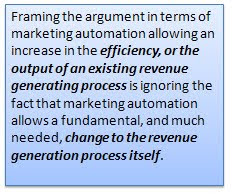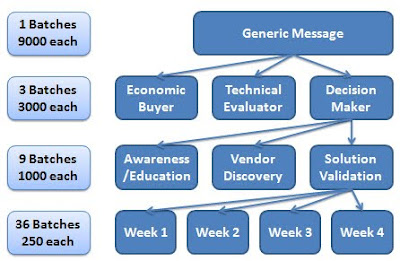This is the comparison I see a challenge with, and viewed in that light, it will be hard to see the level of value that is being seen today by the best marketers.
 If you look at what marketing automation does in terms of business transformation, it is insufficient to characterize it in terms of simply just an efficiency gain, or a revenue gain. It changes the way that we, as B2B marketing organizations, are able to interact with prospects, and opens up new avenues of prospect understanding and prospect communication that simply would not have been viable without marketing automation.
If you look at what marketing automation does in terms of business transformation, it is insufficient to characterize it in terms of simply just an efficiency gain, or a revenue gain. It changes the way that we, as B2B marketing organizations, are able to interact with prospects, and opens up new avenues of prospect understanding and prospect communication that simply would not have been viable without marketing automation.A comparison is the transition from film to digital cameras. If you look at what is possible with film cameras, in terms of photo sharing, digital editing, virtually unlimited photo storage, and the social media use of photos, it is clear that digital cameras present an entirely new way of interacting with images. If contemplated from a framework of film photography, you might look at something like sharing a photo to Facebook and think of digital cameras as offering an efficiency gain; it’s possible with film, you just snap the photo, develop it, scan it, save it to a file, and then upload it. Much less “efficient” but still possible.
However, this misses the point. These things are not simply spectrums of efficiency or revenue, as there is a certain point at which the task would simply not be done.
If you look at the business process that B2B marketers using marketing automation are working to enable, it has a similar challenge. A simple way of looking at it is that we are seeking to:
a) Understand prospective buyers through reading their digital body language
b) Communicate with them accordingly, either through lead nurturing when they are early in their buying process, or through sales engagement if they are later in their buying process
The challenge with making a direct comparison between marketing as enabled and automated with today’s marketing automation software platforms, and marketing without using automation is that the level of buyer understanding and engagement being sought is simply not attainable without automation in any practical way.
 To put the marketing situation in context, using marketing automation, we are attempting to deliver the right message to the right buyer at the right time. This means that we might use digital body language to understand the buyer’s role in the buying process (technical evaluator vs economic buyer), we might seek to understand where they are in their buying cycle (awareness/education vs vendor discovery vs solution validation), and we might attempt to time a message a week after they last engaged with us in order to remain top of mind.
To put the marketing situation in context, using marketing automation, we are attempting to deliver the right message to the right buyer at the right time. This means that we might use digital body language to understand the buyer’s role in the buying process (technical evaluator vs economic buyer), we might seek to understand where they are in their buying cycle (awareness/education vs vendor discovery vs solution validation), and we might attempt to time a message a week after they last engaged with us in order to remain top of mind.Building this with outbound, batch and blast marketing solutions leads to a fundamental problem. Even with this simple version of buyer understanding and message personalization, the level of personalization required quickly moves you from a single communication per month, of perhaps 9000 recipients, to 36 individual communications, each only going to 250 people. On top of this, the lack of built-in awareness of buyers’ digital body language would mean that you had 36 individual segments to select, based on an off-line analysis of the prospect’s behavior.
This leaves us in a similar comparison to the digital vs film photography example. Much as sharing photos on Facebook is theoretically possible using film photography, but in practical terms virtually impossible, marketing in a way that understands and responds to buyers’ digital body language is, in any practical terms, impossible without marketing automation software. You must compare one overall approach with another, and understand it in aggregate.
So, when compared in aggregate, it is tempting to come back to the argument that it only makes sense in terms of a revenue gain or a cost decrease. This is not altogether false, but must be understood in context of your overall market. As it is not possible to truly understand and respond to the unique buying process of each of your buyers without a marketing automation solution, the comparison must now be understood in the context of the competitive landscape. If your competition is understanding and engaging the prospective buyers in your industry based on their individual buying processes, while you are not, they will have access to revenue that you simply will not have access to.
Framing the argument in terms of marketing automation allowing an increase in the efficiency, or the output of an existing revenue generating process is ignoring the fact that marketing automation allows a fundamental, and much needed, change to the revenue generation process itself.






3 comments:
Good points. I'd like to reinforce your last paragraph on fundamental change with the following observation.
Sales and Marketing (and Channels) largely operate as silos today. Integration is often at a data-level - I take data, add something to it, and toss it over the wall to you. Process-level integration is the ultimate goal where there are no artificial functional walls in the contact-to-contract lifecycle.
This silo mentality limits the possibilities of emerging technologies. Traditional marketing is based on (and views itself as) a 1-to-Many interaction model. Sales views itself as a 1-to-Few/1-to-1 models. So for example, as much as marketers get excited over social media, these tools actually have far greater potential by Sales whose structure is already "optimized" for 1-to-1/1-to-Few interactions.
In other words, when Marketers are leveraging social media tools to help their Sales teams have specific/authentic/candid conversations with their prospects and customers, that's when we will know we have achieved process-level integration of the Sales & Marketing function.
Happy Holidays.
Sree,
It’s an interesting point on social media being 1 to 1 or 1 to Few... I think social media is an interaction style that defies a categorization that is quite that obvious. The initial back-and-forth, whether it’s on a blog, Twitter, or Facebook definitely is. However, the real value seems to be in the subsequent “discovered” interaction – ie, everyone else coming across the original discussion. In that case, it really becomes more of a 1 to Many.
Perhaps neither metaphor really fits. It’s more of a 1 to 1(+many) structure.
Good food for thought though.
Steve
You are right. I'm backing off my initial 1-1/many hypothesis. You are also pointing out something else that is important ... and that is not to draw broad conclusions from the current manifestation of social media technology so early in its evolutionary journey. The labels are also somewhat problematic in the sense that "social", "networking", and "media" are timeless concepts...the difference seems to be that today it is a lot more technology-enabled.
Post a Comment